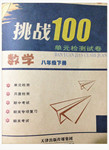题目内容
It is outer space might provide us with new energy sources.
A.where B.which C.what D.that
D
【解析】
试题分析:句意:外太空可能会提供给我们一些新的能源。A.where地点状语,引导定语从句、名词性从句或状语从句;B.which引导定语从句,做主语或宾语; C.what引导名词性从句,做主语或宾语;D.that引导定语从句,做主语或宾语;引导名词性从句,不做任何成分或与It is构成强调句。强调句的陈述结构是it is+被强调部分+that,去掉句子仍然完整。故选D。
考点:考查强调句的用法。

练习册系列答案
 挑战100单元检测试卷系列答案
挑战100单元检测试卷系列答案
相关题目